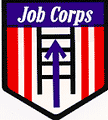|
Job Corps course title: Carpentry. Students in this class learn skills common to the carpentry trade. Operating basic hand and power tools highlights hands-on experiences in all areas of construction.
On the job, the jobs depend on the type of construction, the type of company, and the particular skills of the Carpenter. Working for a small home builder, a Carpenter might be involved in every part of a project, such as putting up the framework, walls, roofs, and installing doors, windows, flooring, cabinets, paneling, and molding. In a larger operation, where there is more opportunity for specialized work, a Carpenter might do only one thing, such as roof framing or installing doors and windows. Most Carpenter's work involves certain basic steps: They read plans, identify and find the materials they need, determine the sizes of the parts required, and measure and mark the materials for cutting. Working with hand tools and power equipment, Carpenters cut and shape the material and assemble or install them following the plans.
Back to Top
Carpenters usually work as part of a crew. The work can be indoors or outdoors, at floor level, or on ladders or scaffolding, often in dusty, noisy places. Training for Carpenters stresses working safely and wearing protective equipment and clothing, because Carpenters can be injured from falling objects, from sharp tools and power equipment, or from falling from high places.
Carpenters provide their own hand tools and work clothing. The employer provides ladders, scaffolding, and any heavy equipment needed on the job. Jobs are different in length, from one-day house repairs to industrial construction projects that last years. In the winter, when it's cold and rainy, there aren't as many jobs for Carpenters. During the winter, many construction carpenters take on small indoor jobs. Most journey-level workers and apprentices belong to locals of the United Brotherhood of Carpenters and Joiners of America. Big city areas are mostly union, but smaller communities have a lot of nonunion workers.
Back to Top
Carpenters with experience, skills, knowledge of new developments in carpentry, and leadership may be promoted to supervisor. Some may become a superintendent or estimator. Those with enough money and business knowledge may become self-employed contractors. Union carpenters progress through apprentice step levels to journey level. Back to Top
In Santa Clara County this field is expected to grow faster than average. Statewide the California Projections of Employment, published by the Labor Market Information Division of the Employment Development Department, estimates that the number of Carpenters in California will reach 92,990 by 2005, an increase in new jobs of 33,070 over the number there was in 1993.
There will also be an estimated 16,750 job openings due to people retiring or leaving the occupation. Added to the 33,070 new jobs expected, this makes for an estimated total of 49,820 job opportunities through 2005.
| Entry Level/No Experience |
| Helpers - Carpenters |
| Median $10.09 |
Mid-Range (25th to 75th percentile) $7.35-$13.14 |
| Carpenters - Union |
| Median $15.40 |
(Santa Clara county Median) $11.00 - $15.46 |
To enroll in this San Jose Job Corps Course: 510 TABE Math/Reading score OR GED/HS diploma.
Job specific skills: The usual way to become a journey-level Carpenter is by completing a four-year apprenticeship program. To become an apprentice, candidates should apply to their local Joint Apprenticeship Committee or the Carpenter's Union. Apprenticeship candidates have to complete the 12th grade or its equivalent, be physically able to do the work, and be at least 17 years old. The union apprenticeship involves on-the-job training and classroom instruction.
Back to Top
|
|



